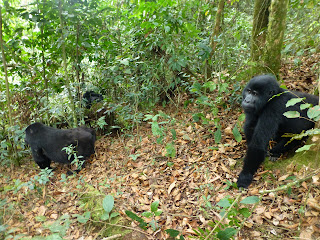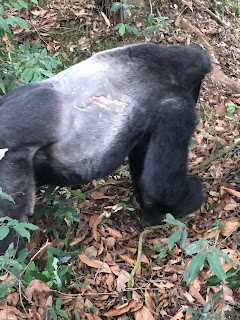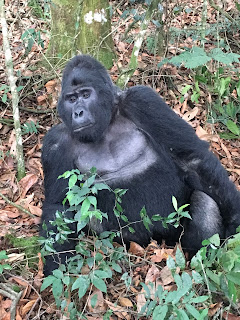We spent an entire hour with these majestic
creatures!
Let me back up.
Will and I had started
talking about gorilla trekking the moment we settled on travelling to Uganda.
We looked into the price of the trip, and knew it was way outside of our travel
budget for the year. Each time we talked about it, it was framed as the Big
Reward… "if we manage to sell our house, our reward will be seeing the
gorillas", "if we manage to sell our vehicles, we'll see the
gorillas", “if we’re careful about saving= gorillas”. And then ALL of these
things happened. Hmm. Even still, we came to Uganda having decided not to see
them. After talking to many people here, tourists and long-term residents, that
decision was reaffirmed- most people did other excursions and went on
incredible adventures, but didn’t see the gorillas. And then, while we were in
Jinja white water rafting, we finally talked to one girl who had done the trip.
Her stories about her experience were so captivating that during a sun set
viewing happy hour, we decided we had to try for gorilla trekking permits. We
soon found out that there are only 8 trekking permits sold for each mountain
gorilla family each day. We were denied permits for the first dates we
requested, but we continued trying alternate dates. We were granted the last 2
permits for August 19.
At 8 am, we set out with
a guide, 2 armed guards, and 6 girls from Belgium. The trail started off fairly
flat, and took us through fields and people’s front yards. It quickly turned
down the hillside, taking us on a steep trip down through tea fields and vines.
We had read that the trek to see this particular mountain gorilla family was
one of the most challenging hikes in Uganda. Along the trail, we ran into an
African wasp nest, and everyone in our group was stung multiple times. Although
my hand and ear became very swollen, the swelling is starting to come down now,
and I didn’t need to use my epipen. The rest of the hike down was fairly
uneventful, albeit filled with excited anticipation. The guide was hacking at
vines with a machete, but we still had to unwrap ourselves from vines and
bushes along the way. They don’t call it the impenetrable forest for no reason!
The Uganda Wildlife Authority has bought a large section of land surrounding
the Bwindi Impenetrable Forest and planted tea.
Mountain gorillas don’t like eating tea plants so these plants act as a
natural fence to keep them in the forest and away from villages. We worked our
way through these tea plants and followed the trail advice we were receiving
via walkie talkie from the trackers who had set out earlier in the morning to
find the gorillas. After two and a half hours of hiking, we set our bags down
and got our cameras ready. We walked another 200 metres to where these
incredible creatures were socializing.
The next hour was the fastest 60 minutes
of our lives, and provided us with the most incredible experience. The group of
mountain gorillas we were observing were the Nkuringo family, consisting of 14
members. The group contains 2 silverbacks and 1 black back, which are all
males. The dominant silverback is named Rafiki, and he fights with the other
silverback anytime he gets close to the females in the group. The group also
has 2 youngsters who were under the age of two. We started off at the advised
distance away, but as we watched them play and move around, the guards moved us
closer in small groups. As we observed them, it was almost as though they were
putting on a performance for us. The younger ones would sit as though they were
posing, and then once they felt like they had our attention, would spin around
the base of a tree or play fight with another gorilla or beat their hands on
their chest. Our guide told us, “when he beat the chest, it’s just of joking”.
We both had opportunities to get quite close to the females, the youngsters,
and dominant silverback. It was a bit eerie to stare into their eyes, as it
felt like they were looking straight into our souls and their eyes usually
looked so sad. It seemed like they could understand us, if only we had the time
to work on developing a mutually agreed upon language. Two of the girls in our
group got a playful swipe towards their legs, but the guards were very good at
grouping us together and predicting their movements. Between the two of us, I
think we managed to get something like 250 photos and 20 videos. However, we
both had moments where we simply had to put down the camera and soak up the
magic of this once in a lifetime experience.
The return hike was a
tough one, as we hiked back up the mountainside. During our lunch break, we had
a really heavy rain and took refuge under a few rain covers. We then continued
up, slipping and sliding along the muddy path. We ended up hiking a total of 14
km, and it was certainly the most rewarding hike we’ve ever done.
10+ Things You Might Not
Know About Mountain Gorillas:
- There’s 880 mountain gorillas left in the world, and half of them reside in Bwindi Impenetrable Forest
- There’s 12 habituated families of mountain gorillas in Bwindi Impenetrable Forest (families you can visit), and only 8 trekking permits sold for each family each day
- It takes two years to habituate mountain gorillas
- Mountain gorillas are only found in Rwanda, Uganda, and Republic of Congo
- The mountain gorillas do not tend to eat very much while have visitors, so the UWA limits human contact to 1 hr per day
- Mountain gorillas cannot live in captivity so you would never see these types of gorillas in a zoo
- We share 98% of our DNA with the mountain gorilla
- Mountain gorillas are friendly vegetarians who are devoted to their family groups
- They usually travel about 1 km per day
- Female don't reach sex maturity until 10 and only have 2-6 babies. The babies stay with their mothers until they are 3 years old. Females live to 30-35 years of age.
- An adult male is 5-6 feet tall, weighs up to 500 pounds, and eat 50 lbs of vegetation each day
- Mountain gorillas live on the ground so their feet are the most human-like out of all the gorillas
- They are very prone to disease, so you cannot be sick at all when you see them
- The best way to help protect them is to visit because the money paid to see them goes towards conservation and protection against hunters
















WOW!!!!! What an incredible experience! I'm so glad for you that you decided to do this amazing once in a lifetime side trip. Beautiful descriptions and glad you created this unique post!
ReplyDeleteI'm so happy you decided to go see te gorillas, you have to do these once in a lifetime experiences! Thank you for your amazing write-ups, you are a grey writer. I love learning about your experiences, it's like we're on a journey too!
ReplyDeleteI'm thrilled as well that you went for the "Big Reward"! Whohoo! Also, all that mountain hiking in Cranrbook and other adventures like the Grand Canyon were all training for that days hike! So glad you are both healthy and able to participate in that. What a chance too that there were two permits available. You soaked up being "millionaries" - why not? What an incredible dynamic for the trekk. To hear about the scouts going out ahead to track, to hear about how they track, it is amazing. I LOVE that between you and Will you have over 250 photos of this event! I don't blame you - but that is an amazing fact.
ReplyDelete